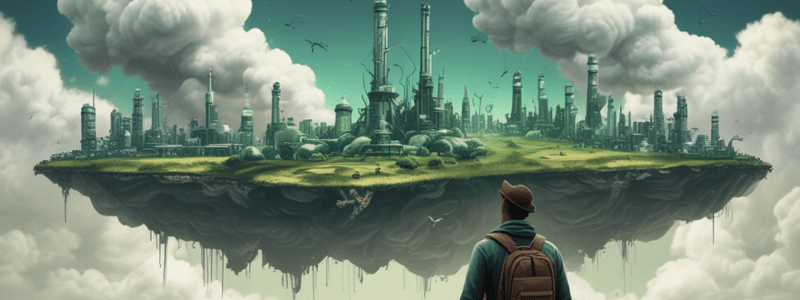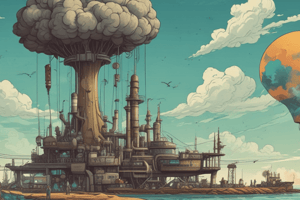Podcast
Questions and Answers
What is the primary definition of pollution?
What is the primary definition of pollution?
- The release of a beneficial substance into the environment
- The act of a harmful or damaging substance being released into the environment (correct)
- The destruction of natural habitats
- The impact of natural disasters on the environment
What are the five recognized categories of pollution?
What are the five recognized categories of pollution?
- Air, water, land, noise, and light (correct)
- Air, water, land, noise, and chemical
- Air, water, land, noise, and temperature
- Air, water, land, noise, and radiation
What is the primary cause of noise pollution?
What is the primary cause of noise pollution?
- The buildup of pollutants in the soil
- The noise of a busy environment (correct)
- The release of harmful gases into the atmosphere
- The release of toxic substances into the environment
What is the effect of light pollution on nocturnal animals?
What is the effect of light pollution on nocturnal animals?
What is the primary cause of environmental pollution?
What is the primary cause of environmental pollution?
What is one example of a cause of air pollution?
What is one example of a cause of air pollution?
What is the impact of human activity on air pollution?
What is the impact of human activity on air pollution?
What is a primary type of physical pollution?
What is a primary type of physical pollution?
What is a way to reduce air pollution?
What is a way to reduce air pollution?
What is chemical pollution?
What is chemical pollution?
What is a common byproduct in industry that is often released from waste incineration?
What is a common byproduct in industry that is often released from waste incineration?
What can fertilizers cause in water supplies?
What can fertilizers cause in water supplies?
What is biological pollution?
What is biological pollution?
What can indicate contamination from humans in water?
What can indicate contamination from humans in water?
What is a way to reduce pollution through green products?
What is a way to reduce pollution through green products?
What is typically the result of the release of harmful substances into the environment?
What is typically the result of the release of harmful substances into the environment?
What type of pollution is caused by the cumulative effect of many lights on the night sky?
What type of pollution is caused by the cumulative effect of many lights on the night sky?
Which type of pollution is caused by the inadvertent release of a harmful substance or the runoff of a harmful substance?
Which type of pollution is caused by the inadvertent release of a harmful substance or the runoff of a harmful substance?
What is the primary source of air pollution according to the text?
What is the primary source of air pollution according to the text?
What is the effect of human activity on the environment according to the text?
What is the effect of human activity on the environment according to the text?
What type of pollution is not caused by a tangible substance?
What type of pollution is not caused by a tangible substance?
What is a type of environmental pollution?
What is a type of environmental pollution?
What is a major contributing factor to physical pollution on Earth?
What is a major contributing factor to physical pollution on Earth?
What is a primary way to reduce environmental pollution?
What is a primary way to reduce environmental pollution?
What can dioxin, a type of chemical pollutant, affect in humans?
What can dioxin, a type of chemical pollutant, affect in humans?
What can pesticides disrupt in an ecosystem?
What can pesticides disrupt in an ecosystem?
What can excessive use of fertilizers cause in water supplies?
What can excessive use of fertilizers cause in water supplies?
What is an example of a biological pollutant?
What is an example of a biological pollutant?
What can indicate contamination from humans in water?
What can indicate contamination from humans in water?
What is the primary way landfills contribute to pollution?
What is the primary way landfills contribute to pollution?
Flashcards are hidden until you start studying
Study Notes
What is Pollution?
- Pollution is the act of releasing harmful or damaging substances into the environment, known as pollutants.
- There are five recognized categories of pollution: air, land, water, noise, and light.
Types of Pollution
- Air pollution is caused by the release of harmful gases into the atmosphere, such as soot or ash from burning substances and toxic gases like carbon dioxide from fossil fuels.
- Land pollution is defined by the presence of toxic substances in soil or litter, including litter, fertilizer runoff, oil spills, and raw sewage disposal.
- Water pollution is caused by factors such as litter, fertilizer runoff, oil spills, and raw sewage disposal.
- Noise pollution is caused by the noise of a busy environment, such as a city.
- Light pollution is caused by the cumulative effect of many lights on the night sky, disrupting nocturnal animals' environments.
Environmental Pollution
- Environmental pollution is the damaging effect of human activity on Earth, specifically land, air, and water.
- Examples of environmental pollution include air, water, and soil pollution.
- Human activities, such as burning fossil fuels and releasing toxic gases, contribute to environmental pollution.
Reducing Environmental Pollution
- Using cleaner forms of energy can reduce air pollution.
- Recycling products and goods can reduce waste and keep materials out of landfills.
- Using green products, or natural products, can replace harmful chemicals and reduce pollution.
Physical Pollution
- Physical pollution occurs when materials or objects are introduced into the environment, causing toxicity or harm.
- Examples of physical pollution include litter, such as incorrectly disposed of water bottles, and landfills.
Landfills
- Landfills are designated areas for trash disposal, lined with a waterproof barrier to prevent soil contamination.
- Landfills contribute to pollution by releasing greenhouse gases and contaminating surrounding soil and land.
Chemical Pollution
- Chemical pollution is the release of harmful chemicals into the soil, air, or water by humans.
- Examples of chemical pollutants include mercury, volatile organic compounds (VOCs), carbon monoxide, and sulfur dioxide.
- Chemical pollutants can come from industrial waste, fertilizers, pesticides, and chemical factories.
- Dioxin is a particularly harmful chemical pollutant that weakens the immune system and affects seed development in plants.
Biological Pollution
- Biological pollution consists of substances derived from nature that cause human harm.
- Examples of biological pollutants include pollen, bacteria, and human fecal matter.
- Biological pollutants can adapt to the environment and indicate contamination from humans.
What is Pollution?
- Pollution is the act of releasing harmful or damaging substances into the environment, known as pollutants.
- There are five recognized categories of pollution: air, land, water, noise, and light.
Types of Pollution
- Air pollution is caused by the release of harmful gases into the atmosphere, such as soot or ash from burning substances and toxic gases like carbon dioxide from fossil fuels.
- Land pollution is defined by the presence of toxic substances in soil or litter, including litter, fertilizer runoff, oil spills, and raw sewage disposal.
- Water pollution is caused by factors such as litter, fertilizer runoff, oil spills, and raw sewage disposal.
- Noise pollution is caused by the noise of a busy environment, such as a city.
- Light pollution is caused by the cumulative effect of many lights on the night sky, disrupting nocturnal animals' environments.
Environmental Pollution
- Environmental pollution is the damaging effect of human activity on Earth, specifically land, air, and water.
- Examples of environmental pollution include air, water, and soil pollution.
- Human activities, such as burning fossil fuels and releasing toxic gases, contribute to environmental pollution.
Reducing Environmental Pollution
- Using cleaner forms of energy can reduce air pollution.
- Recycling products and goods can reduce waste and keep materials out of landfills.
- Using green products, or natural products, can replace harmful chemicals and reduce pollution.
Physical Pollution
- Physical pollution occurs when materials or objects are introduced into the environment, causing toxicity or harm.
- Examples of physical pollution include litter, such as incorrectly disposed of water bottles, and landfills.
Landfills
- Landfills are designated areas for trash disposal, lined with a waterproof barrier to prevent soil contamination.
- Landfills contribute to pollution by releasing greenhouse gases and contaminating surrounding soil and land.
Chemical Pollution
- Chemical pollution is the release of harmful chemicals into the soil, air, or water by humans.
- Examples of chemical pollutants include mercury, volatile organic compounds (VOCs), carbon monoxide, and sulfur dioxide.
- Chemical pollutants can come from industrial waste, fertilizers, pesticides, and chemical factories.
- Dioxin is a particularly harmful chemical pollutant that weakens the immune system and affects seed development in plants.
Biological Pollution
- Biological pollution consists of substances derived from nature that cause human harm.
- Examples of biological pollutants include pollen, bacteria, and human fecal matter.
- Biological pollutants can adapt to the environment and indicate contamination from humans.
Studying That Suits You
Use AI to generate personalized quizzes and flashcards to suit your learning preferences.




